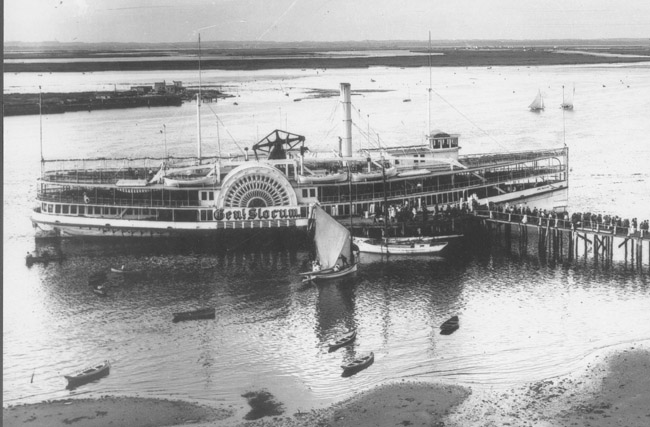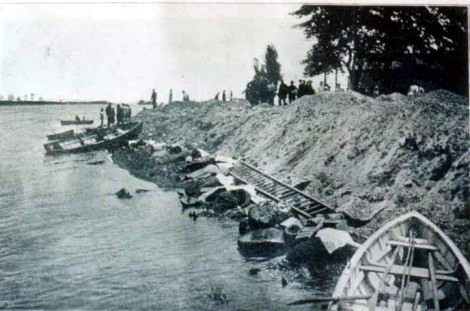On 15 June 1904 the General Slocum was taking members of St. Mark’s Evangelical Church to its annual picnic. Sadly, most would perish when the ship caught fire making it the worst maritime disaster in New York City and for a time the United States until Titanic sank in 1912.

Image:Public Domain (National Archives)
The PS General Slocum was built in Brooklyn, New York in 1891. She was designed as a sidewheel passenger steamboat to ferry passengers to locations on the East River. Named for the famous Civil War general (and New York Congressman), Henry Warner Slocum, the ship conveyed the image of reliability. With three decks-main, promenade and hurricane-and with the capacity to hold up to 2,500 passengers, the ship was very popular especially with groups that were holding major events and needed a ship to convey them.
The Slocum was owned by the Knickerbocker Steamship Company and had been captained for many years by William H. Van Schaick with a total crew of 22 aboard. It had several mishaps before the 1904 disaster. After launching in 1891, she ran aground in Rockaway and tugboats had to pull her free. 1894 saw a number of accidents from running into a sandbar, running aground, and colliding with a tugboat that had caused serious damage. In 1902, the ship ran aground and was stuck there overnight forcing the passengers to camp out on the ship for the night.
By 1904, the Slocum had been superseded by other more modern ships but was still popular for excursion travel around New York City. St. Mark’s Evangelical Church in Little Germany district (Kleindeutschland) of New York had used the Slocum for its annual picnic for the past 17 years. The annual picnic was to celebrate the end of the Sunday School year. Teachers, mothers, and children attended this event. Since it was held during the weekday, most fathers were at work. Pastor George Haas had chartered the ship for $350. On 15 June 1904, the group of 1,358 of mostly women and children boarded the ship at the Third Street Pier. The Slocum would take them up the East River and then through Long Island Sound to its destination of Locust Grove, in Eaton’s Neck, Long Island where the picnic would be held.
The ship departed at 9:30 am and everything seemed to be going well. Nearly all the passengers, mostly women and children, were dressed up for the event. There was a band playing music and food for the trip was served by those attending the picnic. By 10 am the Slocum had made her way up to the passage of Hell Gate, between Ward’s Island and Queens. It was around this time a fire broke out in the Lamp Room. The Lamp Room (the third compartment from the bow under the main deck) as the name indicates, was used to store lamps and its oil. Rags with oil on them were around and packing straw was also in the room as well from the boxes of glasses the group had brought with them for the trip. No one can say for certain how the fire was started, but most likely caused by a discarded cigarette or match. The fire was soon noticed by crew who attempted to put it out using the emergency water hoses. Unfortunately, they were old and leaked so little water could be applied. It would be learned later that the company that sold them to Knickerbocker had used materials that were quite thin and cheap.
The captain was first notified by a child but dismissed it. He was officially told 10 minutes later but by now the fire was ablaze and passengers were now getting frightened. The ship was equipped with lifeboats, but they could not be released. They were held in place by wire and in many cases were covered with paint making it impossible to release them. People were getting frantic now. Life preservers were available but were so old that the cork inside had disintegrated into dust. And the dust absorbed water. In some of them were bits of metal put in by the manufacturer to make them weigh the same as ones with cork. Mothers watched in agony as the children they had put life preservers on sink and drown in the water. Also, few knew how to swim at the time as well so could not swim to safety. Adding more to this situation were that at the time people wore wool clothing even in summertime. So even if they could swim, it was very difficult with the heaviness of the wool weighing you down.
Captain Van Schaick initially ordered the ship full ahead as the nearest area of land had oil storage. He would change his mind a few minutes later and order the ship beached on North Brother Island. He would remain on the Hurricane deck until the last moments of the ship forced him to jump overboard into shallow water. The ship had been completely engulfed by the time she was beached-a mere 20 minutes after the fire had been discovered, Fortunately North Brother Island was a quarantine island and there were both doctors and nurses to assist those that had gotten ashore. Several vessels nearby had come to assist those they found in the water and responsible for saving 300 lives.

15 June 1904
Possible source: Gustav Scholer (1851 – 1928)
Public Domain via Wikimedia Commons
Most however did not make it off the Slocum. An estimated 1021 would die according to a government report and of that only 2 were crew (though some sources put the figure lower). Sadly, many who died were children though sometimes parents or members of the extended family also perished. Some victims were never identified because there was no one living to do so. The funeral procession of the dead was witnessed by many, and the small coffins caused many to cry. One notable incident was a man accompanied by his wife carrying a small coffin under his arms. He could not afford a funeral wagon and so was walking to the cemetery. Fortunately, a man delivering flowers offered him a ride. Captain Van Schaick was injured in an eye and lost its use as result of the tragedy.
The city was aghast at what had happened. In supposedly one of the great cities of the world, a ship burned within its sight. A floating horror of fire and people frantically trying to escape facing either the flames or drowning. Newspapers carried headlines of the many funeral processions that occurred. Everyone wanted answers and President Roosevelt ordered a commission to investigate what had happened on the Slocum. And what the commission found was startling. Nothing had been done to maintain and replace as needed the safety equipment. The report found the fire hoses were made of cheap linen and full of kinks (and of course leaked). And of course, how the life preservers had failed as well along with the lifeboats that could not be accessed. Also, they found no safety drill had been done in over a year. Captain Van Schaick was found responsible as master of the Slocum and sentenced to 10 years in jail for failing to maintain the safety equipment. Since the captain bore the brunt of the blame, the Knickerbocker Steamship Company paid only a small fine though it was learned they had falsified safety records.
Later Van Schaick would be paroled and pardoned by President Taft in 1912 since many believed the company was at fault.
Aftermath
As a result of the tragedy, a reorganization of who was responsible for inspecting ships and tighter safety regulations would result. Today that is handled by the U.S. Coast Guard. The community of Little Germany in Manhattan was severely affected with the loss of so many in the tragedy. It brought the community together and St. Mark’s would continue to serve its community. Little Germany had grown and flourished from the 1840’s but by the end of the 19th century had already started to contract. The once solidly German area began to diminish and in many ways the tragedy of the General Slocum hastened it. Many began to resettle in Brooklyn. A new wave of immigrants was coming in from Italy and Eastern Europe. It would become eventually the Lower East Side forever changing the character with areas where Italian, Russian, and Yiddish would now be heard.
St. Mark’s Evangelical Church would never recover from the 1904 loss as most of its congregation were dead. While the parish would continue elsewhere, the church would become a synagogue (and still is to this day) in 1940. The building itself is listed on the U.S. National Register of Historic Places. In 1946 the parish of St. Mark’s merged with the Zion Church in Yorkville in 1946 to become Zion St. Mark’s Evangelical Lutheran Church.

Image:Public Domain (Wikipedia)
In 1906 a marble memorial fountain, which stands to this day, was erected in Tompkins Square Park in Manhattan by the Sympathy Society of German Ladies. There is also another memorial in the Lutheran All Faiths Cemetery in Middle Village, Queens where many graves of the victims are to be found. The last survivor died in 2004.
The General Slocum was salvaged and turned into a barge renamed Maryland. Continuing its history of mishaps as before, it sank in the South River in 1909 and in 1911 while in the Atlantic off the coast of New Jersey. No one died in the 1911 sinking.
The movie Manhattan Melodrama (1934), which stars a young Clark Gable, has as its opening moments the events of the General Slocum which sets in motion the lives of the two characters the movie depicts. Not a bad movie for its time and worth looking at if you have the opportunity.
A memorial plaque placed near the former church of St. Mark’s on the centennial of disaster states:
This is the site of the former St. Mark’s Evangelical Lutheran Church (1857–1940) a mostly German immigrant parish. On Wednesday, June 15, 1904, the church chartered the excursion steamer, GENERAL SLOCUM, to take the members on the 17th annual Sunday school picnic. The steamer sailed up the East River, with some 1400 passengers aboard, when it entered the infamous Hell Gate passage, caught fire and was beached and sank on North Brother Island. It is estimated 1200 people lost their lives, mostly woman and children, dying within yards of the Bronx shore.
The GENERAL SLOCUM had been certified by the U.S. Steam boat Inspection Service to safely carry 2500 passengers five weeks before the disaster. An investigation after the fire and sinking found the lifeboats were wired and glued with paint to the deck, life jackets fell apart with age, fire hoses burst under water pressure, and the crew never had a fire drill. Until the terrorist attack on the World Trade Center on September 11, 2001, the Slocum disaster had been the largest fire fatality in New York City’s history.
Dedicated Sunday, June 13, 2004, by the Steam Centennial Committee.
The Maritime Industry Museum
SUNY-Maritime College, Fort Schulyer, The Bronx, NY
Sources
History.com Editors. (2020, June 12). Fire on Riverboat leaves more than 1,000 dead. History.com. https://www.history.com/this-day-in-history/river-excursion-ends-in-tragedy
The General Slocum Disaster of June 15, 1904 | The New York Public Library. (2011, June 13). The New York Public Library. https://www.nypl.org/blog/2011/06/13/great-slocum-disaster-june-15-1904
General Slocum | National Underwater and Marine Agency. (n.d.). https://numa.net/expeditions/general-slocum/
Wikipedia contributors. “PS General Slocum.” Wikipedia, Aug. 2023, en.wikipedia.org/wiki/PS_General_Slocum. Accessed 11 June 2024
Wikipedia contributors. “Little Germany, Manhattan.” Wikipedia, Aug. 2023, en.wikipedia.org/wiki/Little_Germany,_Manhattan. Accessed 11 June 2024
Zion-St. Mark’s Evangelical Lutheran Church. (n.d.). http://www.zionstmarks.org/ourhistory.htm
Videos
Fascinating Horror. (2023, August 8). The General Slocum | a short documentary | Fascinating horror [Video]. YouTube. https://www.youtube.com/watch?v=38NfsPVC6m8. Also available on Rumble: https://rumble.com/v3kq60p-the-general-slocum-fascinating-horror.html
Hank Linhart. (2017, June 13). Fearful visitation, The Steamship Fire of the General Slocum,1904 [Video]. YouTube. https://www.youtube.com/watch?v=ZU1QzU8tCnk
The History Guy: History Deserves to Be Remembered. (2017, June 15). New York’s worst maritime disaster, the General Slocum [Video]. YouTube. https://www.youtube.com/watch?v=tGlLwtqhUKE. Also available on Rumble: https://rumble.com/v2nsnrq-new-yorks-worst-maritime-disaster-the-general-slocum.html
Suggested Reading
Editors, C. R. C. R. (2015). The sinking of the General Slocum: The History of New York City’s Deadliest Maritime Disaster. CreateSpace.
Eggleston, M. A. (2021). Fire on the water: the General Slocum disaster. Independently Published.
O’Donnell, E. (2004). Ship ablaze: The Tragedy of the Steamboat General Slocum. Crown.
Titanic News Channel is a participant in the Amazon Services LLC Associates Program, an affiliate advertising program designed to provide a means for sites to earn advertising fees by advertising and linking to Amazon.com.









